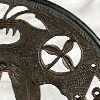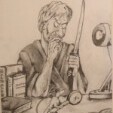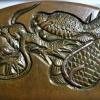-
Posts
2,222 -
Joined
-
Last visited
-
Days Won
7
Shugyosha last won the day on July 10 2022
Shugyosha had the most liked content!
About Shugyosha

Profile Information
-
Gender
Not Telling
-
Location:
Just beyond the edge
-
Interests
Non-military swords and koshirae.
Profile Fields
-
Name
John J.
Recent Profile Visitors
The recent visitors block is disabled and is not being shown to other users.
Shugyosha's Achievements
-

Auction at Grantham on 27th March
Shugyosha replied to Shugyosha's topic in Auctions and Online Sales or Sellers
Thanks guys, I do appreciate the kind words. -

Auction at Grantham on 27th March
Shugyosha replied to Shugyosha's topic in Auctions and Online Sales or Sellers
Thank you gentlemen! -
Dear All, I've been havering over what to do with the balance of my collection but personal circumstances have reared their ugly head and have unfortunately dictated that I have to sell up. Apologies for not offering items for sale on the board but I don't have the heart to deal with haggling and packing stuff up and mailing it out, so I've lobbed it in to a local UK auction: https://auctions.gol...077?page=2&items=100 My items are numbers 126 to 151. None of the items has a reserve price, so bargains may be had and, if anyone bids successfully, can you please let me know and I will make a donation to the board in consideration for the publicity had here. Thanks for looking.
-
I think you're right Russ - looks like 永正 to me too.
-
Hi Hannah, I’m honestly not sure how strong the connection is and it might just be coincidence but many schools of tsuba makers got their names from the places where they worked. I’ll have a dig around and see what I can turn up.
-
Hi Hannah, Sorry if this has been mentioned before but, if you haven't done so already, have a google around the words "shippou" and "shippou yaki. Shippou yaki 七宝焼 or しっぽうやき in hiragana is the name for the craft of Japanese enamel cloisonne work as it will give you some idea of the likely dates and area of production of your tsuba. You'll probably also get some hits on tsuba with an interlaced netted pattern resembling the "cloisons" of the enamel tsuba and a style of sword fittings but without the enamel infill so you'll need to filter these. As Brian has said, your tsuba is probably no early than the 17th century as this is apparently when cloisonne work took off in Japan: https://katoshippo.c...story-of-cloisonne_e In tsuba collecting and other Japanese arts there is the idea of "Hamamono" - things sold at the harbour. As you'll likely know, when Japan opened to the West in the 19th century there was great demand for articles of Japanese art to satisfy European fascination with orientalism, so lots of tsuba and other kinds of art objects were exported in bulk and these were of mixed quality as mass-production industries grew up to satisfy the demand in western countries (also, the Japanese not being fools, kept the best stuff for themselves). There's a chance that your tsuba was made or exported to Europe at this time or, of course, there may be many other explanations as to how it arrived here but it might be worth mentioning in your paper. Anyhow, Nagasaki was a significant port involved in this export trade and, as Brian said above, Nagasaki is also a place associated with cloisonne tsuba so this might be worth a mention too. Good luck with your project and top marks for your research in finding a bunch of nerds like us to talk to.
-
Hi Andrea, Some blades have a mix of types of hamon or hada. Most of the descriptions of the characteristics of blades by smiths or schools of smiths are of a blade that can be fitted perfectly into that smith or school's work. In real life, a blade may not fit 100% with the characteristics of the "ideal" blade which is where things get complicated because the first thing that you learn is that there are rules, and a little later that there often exceptions to them and they become more like "guidance" than principles set in stone. That's why it's very hard for us in the West to see enough blades to be competent beyond the basics of kantei (I know that I'm not, and the basics may not be there either). Anyway, I hope that you're enjoying your blade more now and that you continue with collecting.
-
Hi David, The one on the Aoi Art website linked was put at around 1624. That would be the penultimate one on the Nihonto Club index.
-
Hi David, just shake it over the tang so that the powder fills any lines in the characters to make them stand out more clearly. That said, I think that Xiayang is on the money with his post above.
-
G'day David, Nice to see you back so soon and bringing more goodies! I think that this one will need sharper eyes than mine but at first blush it looks like it might be another traditionally made blade rather than a standard army sword as I can't see any stamp and it's a proper signature as opposed to the chippy rush job ones on the standard issue blades. I think I can make out the first two characters on the tang "豊後" Bungo which is the province in Japan where the sword was made and I'm assuming that the third character is "住" Juu - meaning a resident of this province but I'm lost after that. Any chance that you could sprinkle the tang with some talcum powder to try to pick out the lines of the characters and post another photograph? Also, if there are any characters on the other side of the tang could you do the same there?
-
Hi RJ, Welcome to the forum. It looks like one of these but the gunto guys will be along in a while to confirm as army swords aren't me field of interest: https://www.japaneseswordindex.com/koa.htm Date reads: 昭和辛巳春 Showa Kanoto-mi haru - Spring 1941. Showa is the nengo period with the year being written using the Chinese sexagenary calendar characters. On the back of the tang is the katakan "tsu" and the production number: ツ [四]三八 - it looks like 438 with the "4" being eroded or worn away. I hope that gets you started.
-
Hi Oliver, It might have been a long wakizashi (calculated by adding the distance between the two mekugi ana to the current length). Andrea, I think that the hamon is notare. If you can set up a room with the curtains drawn and a single light or point of light, then move the blade around so that the light plays up and down the hamon, you should be able to see the real hamon through the hadori with the nioi guchi shining through like a bolt of lightening. Have a look at the photos in this thread and see how the line of the hamon shines where it is just to the edge of where the light obscures it. Please don't be upset, you've done no worse than many of us with a first blade and I have one where the polisher went way overboard with the hadori to create what he thought was a more "pleasing" hamon. The shape of the blade is typical of an early Edo period blade so nothing to worry about there. As regards your studies, as someone has said above, seeing blades and looking at them compared to what you have studied is key as it is difficult to learn from books alone.
-
I’m sorry but I’m concerned about that hamon, it has had some serious hadori applied. It’s hard to see any activity in the hamon and you can see some of the original tang patina under the “hamon” which means it is not genuine. I’m not saying that there isn’t a hamon there, just that it has been enhanced. Also, there are practically no machi so for a shinto blade its condition is well below par. Apologies for being negative, which I genuinely hate to do, but the blade has issues. Could you return it?
-
I agree with John. It looks to me like perhaps an unsigned shin shinto blade that someone decided to add a signature to in order to make it look older, though it does look chiselled unlike the usual gold sharpie kinpun mei that is seen on a number of blades at the moment. It does look like a nice blade though, congratulations Ed!







